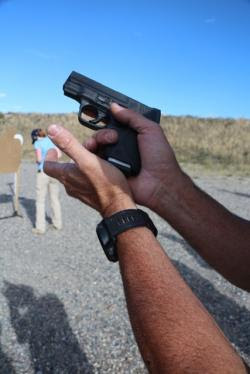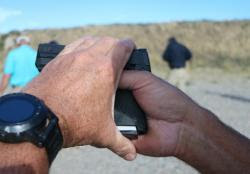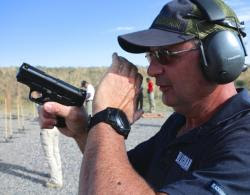Three Quick Tips for Pocket Pistols
They're the easiest to conceal, but the hardest to manage. Those diminutive pocket pistols that are popular for concealed carry in a variety of situations may be comfortable to carry and comforting in their protective capabilities, but they're the hardest of the already difficult guns to shoot: handguns.
"Pocket pistols are always a handful," says multi-time world shooting champion, instructor and Blackhawk! pro Todd Jarrett, "and they just don't run if they're not handled correctly. If people aren't strong enough to manage them from manipulating their slide to handling their recoil, I just tell them -get a revolver. This won't work for you."
Having spent a few hours on the range with Jarrett [recently], it's obvious he knows how to make the pocket rockets run -up close and at a distance. He laughed about how people are always telling him "these little guns with two-inch barrels are only made for shooting at 10-20 feet." He then pulled out an out-of-the-box Smith & Wesson M&P Shield from a tiny new Safariland holster and blasted a tiny patch of grass -more than 90 yards away down the shooting bay.
While working with him, I learned there were more than a few things I could improve about my personal gun handling. It was valuable because his tips were done using the M&P Shield- a deep concealment gun I've shot as much as almost any pistol any I own, and far more than any other small one.
Three of the quick tips he shared were definitely worth sharing - and they're primarily image based, which makes them even simpler to understand.
First, he corrected my (bad) habit of inserting the small magazine and whacking the bottom of it with my hand to insert it. As he pointed out, there's a tendency to "bite yourself" when you do that- but it's tough to be certain the magazine's inserted.
PHOTO: This is NOT the Todd Jarrett approved method for inserting mags into small pistols (top). Instead, he advocates using the weak-hand and fingers to slide and snap the mag into the magwell (below). He also says "don't baby it, let the slide 'snap' forward, it's the way the guns' designed to work."

I tried it, and despite the fact my off-hand truly is weak due to a longstanding health issue, it worked.
OK, that's one way to make certain you're not waving your pistol around at the range.
Here's a two-part safety tip when loading and making your gun "hot" - first, don't ever grab the front of the slide like you might do with a full-sized gun. There's a potential for several bad things to happen. The most dangerous is that you're likely to cover the muzzle of the gun with one or more of your fingers. If the gun has any sort of mechanical problem - and Jarret's quick to remind us that "pistols can break" - well, you'll find yourself, at best, with a hole somewhere in your hand. You could find yourself missing a significant part of the entire hand. As he reminded us, "it has happened."
And he's quick to encourage you to let things work naturally. "The slide's designed to absorb the recoil, compress the recoil spring, then snap quickly forward," he reminds the group, "you shouldn't do anything to impede that action -pull the slide back, crisply, then release it and let it snap back into position."
A final safety tip for today is applicable for any pistol, regardless of its size. Having watched Jarrett compete over the years, he's always been one of those people who always seems to manipulate his pistol "up high" - as above his shoulders and directly in his natural eye line. He's quick, but after 32 years of competition and millions of repetitions, his shooting seems to come as easily as his smile.
He works high because it keeps his head up and on the targets- like his rear sight, he doesn't have to look at his hands, his magazine or his pistol when working high.
PHOTO: Jarrett always "works high" when manipulating his gun and magazine (top) It keeps his eyes downrange, but it also enables him to keep his week hand in a position to control a gun that could break and go full-auto. He's also experienced enough to watch and coach lesser experienced shooters from a distance (below)

Turns out there's another safety reason he keeps the gun up high and his weak hand between it and his face.
"If the extractor breaks," he explained, "the gun can malfunction and going full-auto until it runs dry. If you're not prepared to control that gun, there's a chance the gun could come back and hit you in the face -or worse." It's a lesson Jarrett said he learned the hard way very early in his career.
"A gun broke and went full auto," he said, "I wasn't prepared to control it like I am today. The last shot came on the muzzle rise only a couple of inches from my face. I felt the pressure from that shot- and it changed my technique forever."
He worked with each of the writers attending a learning session with his longtime sponsor Blackhawk! and after a bit of time with him, each of us was performing better. Nothing like Jarrett, but not many do shoot as well - even as he's becoming one of the elder statesmen in professional shooting.
Republished from The Outdoor Wire.
- 3249 reads

